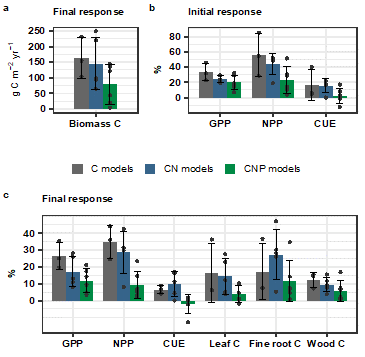The Science
The role of phosphorus availability has not been considered in any of the CMIP5 models. This study shows that phosphorus availability could greatly reduce the projected CO2-induced carbon sink in Amazon rainforests. This study suggests that the Amazon rainforest response to increasing atmospheric CO2 depends upon the ability of trees to up-regulate phosphorus acquisition in response to increased carbon availability.
The Impact
Currently CMIP5 models predict that the Amazon rainforest will continue to act as carbon sinks in the future due to the CO2 fertilization effect. However the role of phosphorus availability (which is impoverished across the Amazon Basin yet controls forest functioning) has not been considered within CMIP5 simulations. This study suggests that the CMIP5 predicted carbon sink would likely be much less due to phosphorus limitation, suggesting Amazon rainforests may be less resilient to climate change than previously assumed.
Summary
An ensemble of 14 terrestrial ecosystem models was used to simulate the planned free-air CO2 enrichment experiment AmazonFACE. Model simulations showed that phosphorus availability reduced the projected CO2-induced carbon sink by about 50% compared to estimates from models assuming no phosphorus limitation. Large variations in ecosystem responses to elevated CO2 among Phosphorus-enabled models (ranging from 5 to 140 g Carbon m-2 yr-2 in biomass carbon response) are mainly due to contrasting representations of plant phosphorus use and acquisition strategies among models. This study highlights the importance of phosphorus acquisition and use, including alternative strategies, in Amazon rainforest responses to increasing atmospheric CO2 concentration.

Contacts (BER PM): Dan Stover and Sally McFarlane, Daniel.Stover@science.doe.gov (301-903-0289) and sally.mcfarlane@science.doe.gov (301-903-0943)
PI Contact: Jeffrey Q. Chambers, Lawrence Berkeley National Lab, jchambers@lbl.gov
Funding
DE-AC02-05CH11231 as part of their Next Generation Ecosystem Experiment-Tropics (NGEE-Tropics) and Exascale Energy Earth System Model (E3SM) programs.
Publication
Fleischer K, A. Rammig, M.G. De Kauwe, A. P. Walker, T.F. Domingues, L. Fuchslueger, S. Garcia, D. Goll, A. Grandis, M. Jiang, V.E. Haverd, F. Hofhansl, J. Holm, B. Kruijt, F. Leung, B. Medlyn, L.M. Mercado, R.J. Norby, B.C. Pak, B. Quesada, C. von Randow, K. Schaap, O. Valverde-Barrantes, Y. Wang, X. Yang, S. Zaehle, Q. Zhu, D. Lapola. Amazon forest responses to CO2 fertilization dependent on plant phosphorus acquisition, Nature Geoscience, https://doi.org/10.1038/s41561-019-0404-9, 2019.